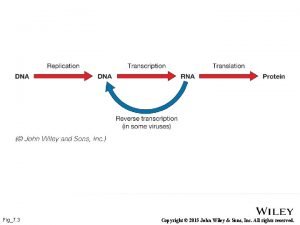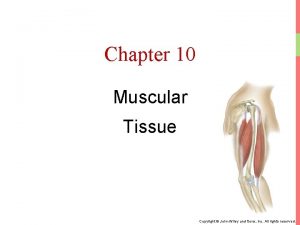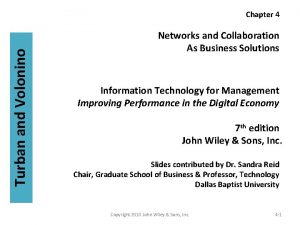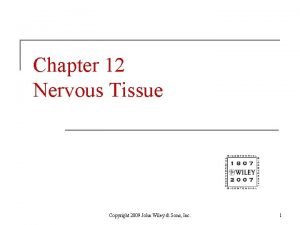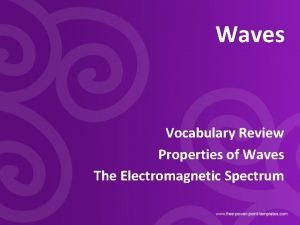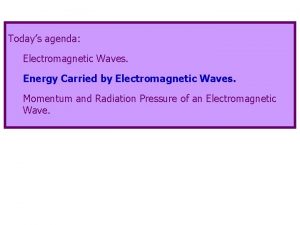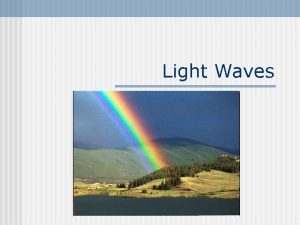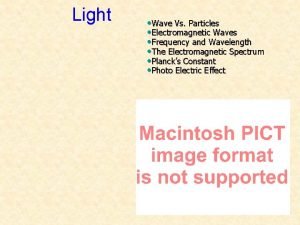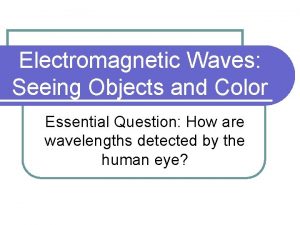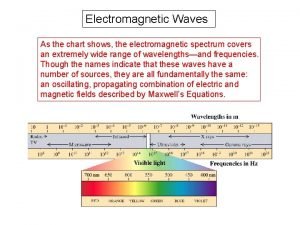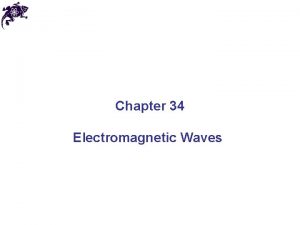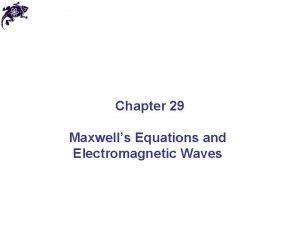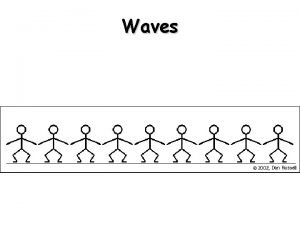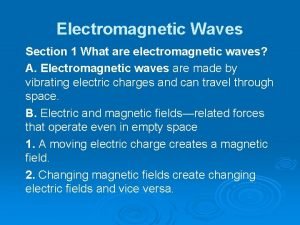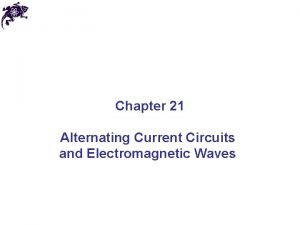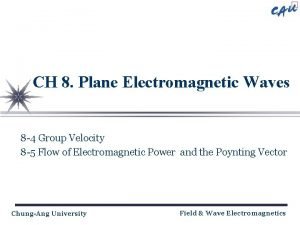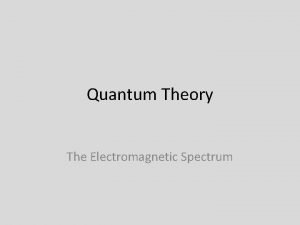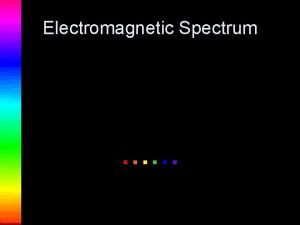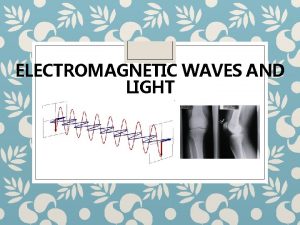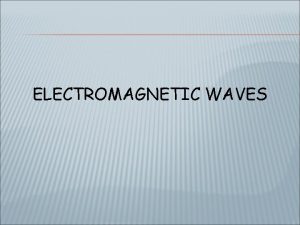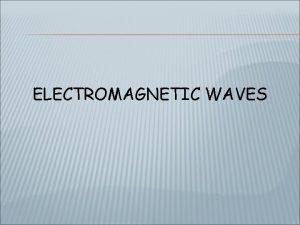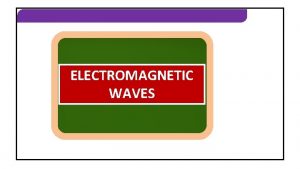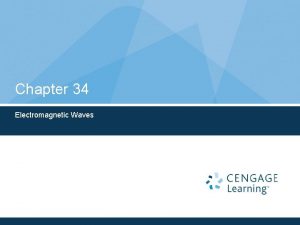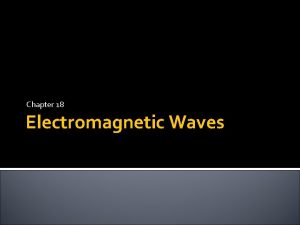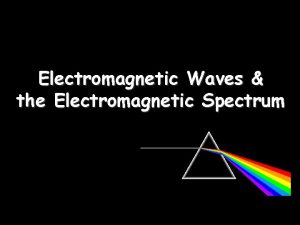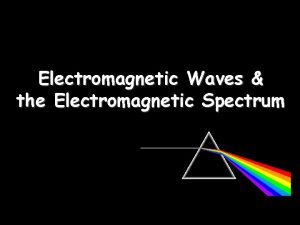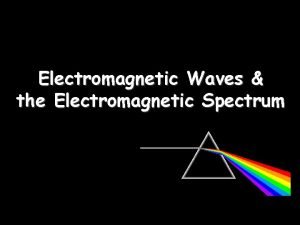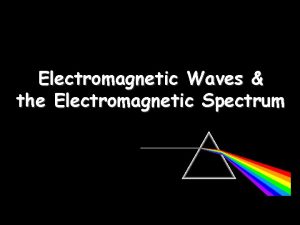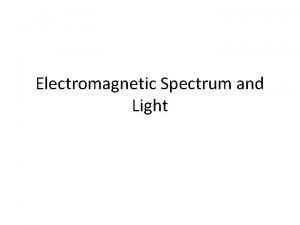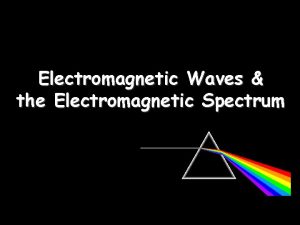Chapter 33 Electromagnetic Waves Copyright 2014 John Wiley






























- Slides: 30

Chapter 33 Electromagnetic Waves Copyright © 2014 John Wiley & Sons, Inc. All rights reserved.

33 -1 Electromagnetic Waves Learning Objectives 33. 01 In the electromagnetic spectrum, identify the relative wavelengths (longer or shorter) of AM radio, FM radio, television, infrared light, visible light, ultraviolet light, x rays, and gamma rays. 33. 02 Describe the transmission of an electromagnetic wave by an LC oscillator and an antenna. 33. 03 For a transmitter with an LC oscillator, apply the relationships between the oscillator’s inductance L, capacitance C, and angular frequency ω, and the emitted wave’s frequency f and wavelength λ. 33. 04 Identify the speed of an electromagnetic wave in vacuum (and approximately in air). 33. 05 Identify that electromagnetic waves do not require a medium and can travel through vacuum. 33. 06 Apply the relationship between the speed of an electromagnetic wave, the straight-line distance traveled by the wave, and the time required for the travel. © 2014 John Wiley & Sons, Inc. All rights reserved.

33 -1 Electromagnetic Waves Learning Objectives (Contd. ) 33. 07 Apply the relationships between an electromagnetic wave’s frequency f, wavelength λ, period T, angular frequency ω, and speed c. 33. 09 Apply the sinusoidal equations for the electric and magnetic components of an EM wave, written as functions of position and time. 33. 08 Identify that an electromagnetic wave consists of an electric component and a magnetic component that are (a) perpendicular to the direction of travel, (b) perpendicular to each other, and (c) sinusoidal waves with the same frequency and phase. 33. 10 Apply the relationship between the speed of light c, the permittivity constant ε 0, and the permeability constant μ 0. 33. 11 For any instant and position, apply the relationship between the electric field magnitude E, the magnetic field magnitude B, and the speed of light c. © 2014 John Wiley & Sons, Inc. All rights reserved.

33 -1 Electromagnetic Waves Learning Objectives (Contd. ) 33. 12 Describe the derivation of the relationship between the speed of light c and the ratio of the electric field amplitude E to the magnetic field amplitude B. © 2014 John Wiley & Sons, Inc. All rights reserved.

33 -1 Electromagnetic Waves Maxwell’s Rainbow In Maxwell’s time (the mid 1800 s), the visible, infrared, and ultraviolet forms of light were the only electromagnetic waves known. Spurred on by Maxwell’s work, however, Heinrich Hertz discovered what we now call radio waves and verified that they move through the laboratory at the same speed as visible light, indicating that they have the same basic nature as visible light. As the figure shows, we now know a wide spectrum (or range) of electromagnetic waves: Maxwell’s rainbow. © 2014 John Wiley & Sons, Inc. All rights reserved.

33 -1 Electromagnetic Waves Travelling Electromagnetic Wave An arrangement for generating a traveling electromagnetic wave in the shortwave radio region of the spectrum: an LC oscillator produces a sinusoidal current in the antenna, which generates the wave. P is a distant point at which a detector can monitor the wave traveling past it. © 2014 John Wiley & Sons, Inc. All rights reserved.

33 -1 Electromagnetic Waves Travelling Electromagnetic Wave Figure 2 Electromagnetic Wave. Figure 1 shows how the electric field E and the magnetic field B change with time as one wavelength of the wave sweeps past the distant point P of Fig. 2 ; in each part of Fig. 1, the wave is traveling directly out of the page. (We choose a distant point so that the curvature of the waves suggested in Fig. 2 is small enough to neglect. At such points, the wave is said to be a plane wave, and discussion of the wave is much simplified. ) Note several key features in Fig. 2; they are present regardless of how the wave is created: Figure 1 © 2014 John Wiley & Sons, Inc. All rights reserved.

33 -1 Electromagnetic Waves Travelling Electromagnetic Wave Figure 2 Figure 1 1. The electric and magnetic fields E and B are always perpendicular to the direction in which the wave is traveling. Thus, the wave is a transverse wave, as discussed in Chapter 16. 2. The electric field is always perpendicular to the magnetic field. 3. The cross product E × B always gives the direction in which the wave travels. 4. The fields always vary sinusoidally, just like the transverse waves discussed in Chapter 16. Moreover, the fields vary with the same frequency and in phase (in step) with each other. © 2014 John Wiley & Sons, Inc. All rights reserved.

33 -1 Electromagnetic Waves Travelling Electromagnetic Wave Figure 2 In keeping with these features, we can deduce that an electromagnetic wave traveling along an x axis has an electric field E and a magnetic field B with magnitudes that depend on x and t: where Em and Bm are the amplitudes of E and B. The electric field induces the magnetic field and vice versa. Figure 1 © 2014 John Wiley & Sons, Inc. All rights reserved.

33 -1 Electromagnetic Waves Travelling Electromagnetic Wave Figure 2 Wave Speed. From chapter 16 (Eq. 16 -13), we know that the speed of the wave is ω/k. However, because this is an electromagnetic wave, its speed (in vacuum) is given the symbol c rather than v and that c has the value given by which is about 3. 0 × 108 m/s. In other words, Figure 1 © 2014 John Wiley & Sons, Inc. All rights reserved.

33 -2 Energy Transport and The Poynting Vector Learning Objectives 33. 13 Identify that an electromagnetic wave transports energy. 33. 14 For a target, identify that an EM wave’s rate of energy transport per unit area is given by the Poynting vector S, which is related to the cross product of the electric field E and magnetic field B. 33. 15 Determine the direction of travel (and thus energy transport) of an electromagnetic wave by applying the cross product for the corresponding Poynting vector. 33. 16 Calculate the instantaneous rate S of energy flow of an EM wave in terms of the instantaneous electric field magnitude E. 33. 17 For the electric field component of an electromagnetic wave, relate the rms value Erms to the amplitude Em. 33. 18 Identify an EM wave’s intensity I in terms of energy transport. 33. 19 Apply the relationships between an EM wave’s intensity I and the electric field’s rms value Erms and amplitude Em. © 2014 John Wiley & Sons, Inc. All rights reserved.

33 -2 Energy Transport and The Poynting Vector Learning Objectives (Contd. ) 33. 19 Apply the relationships between an EM wave’s intensity I and the electric field’s rms value Erms and amplitude Em. 33. 20 Apply the relationship between average power Pavg, energy transfer ΔE, and the time Δt taken by that transfer, and apply the relationship between the instantaneous power P and the rate of energy transfer d. E/dt. 33. 22 For an isotropic point source of light, apply the relationship between the emission power P, the distance r to a point of measurement, and the intensity I at that point. 33. 23 In terms of energy conservation, explain why the intensity from an isotropic point source of light decreases as 1/r 2. 33. 21 Identify an isotropic point source of light. © 2014 John Wiley & Sons, Inc. All rights reserved.

33 -2 Energy Transport and The Poynting Vector: The rate per unit area at which energy is transported via an electromagnetic wave is given by the Poynting vector The time-averaged rate per unit area at which energy is transported is Savg, which is called the intensity I of the wave: A point source of electromagnetic in which Erms= Em/√ 2. waves emits the waves isotropically —that is, with equal intensity in all directions. The intensity of the waves at distance r from a point source of power Ps is © 2014 John Wiley & Sons, Inc. All rights reserved.

33 -3 Radiation Pressure Learning Objectives 33. 24 Distinguish between force and pressure. 33. 25 Identify that an electromagnetic wave transports momentum and can exert a force and a pressure on a target. 33. 27 For a uniform electromagnetic beam that is perpendicular to a target area, apply the relationships between the wave’s intensity and the pressure on the target, for both total absorption and total backward reflection. 33. 26 For a uniform electromagnetic beam that is perpendicular to a target area, apply the relationships between that area, the wave’s intensity, and the force on the target, for both total absorption and total backward reflection. © 2014 John Wiley & Sons, Inc. All rights reserved.

33 -3 Radiation Pressure When a surface intercepts electromagnetic radiation, a force and a pressure are exerted on the surface. If the radiation is totally absorbed by the surface, the force is Total Absorption in which I is the intensity of the radiation and A is the area of the surface perpendicular to the path of the radiation. If the radiation is totally reflected back along its original path, the force is Total Reflection back along path The radiation pressure pr is the force per unit area: Total Absorption and Total Reflection back along path © 2014 John Wiley & Sons, Inc. All rights reserved.

33 -4 Polarization Learning Objectives 33. 28 Distinguish between polarized light and unpolarized light. 33. 29 For a light beam headed toward you, sketch representations of polarized light and unpolarized light. 33. 32 For a light beam incident perpendicularly on a polarizing sheet, apply the one-half rule and the cosine-squared rule, distinguishing their uses. 33 Distinguish between a polarizer and an analyzer. 33. 30 When a beam is sent into a polarizing sheet, explain the function of the sheet in terms of its polarizing 33. 34 Explain what is meant if two direction (or axis) and the electric sheets are crossed. field component that is absorbed and 33. 35 When a beam is sent into a the component that is transmitted. system of polarizing sheets, work 33. 31 For light that emerges from a through the sheets one by one, polarizing sheet, identify it finding the transmitted intensity and polarization relative to the sheet’s polarization. polarizing direction. © 2014 John Wiley & Sons, Inc. All rights reserved.

33 -4 Polarization Electromagnetic waves are polarized if their electric field vectors are all in a single plane, called the plane of oscillation. Light waves from common sources are not polarized; that is, they are unpolarized, or polarized randomly. If the original light is initially unpolarized, the transmitted intensity I is half the original intensity I 0: If the original light is initially polarized, the transmitted intensity depends on the angle u between the polarization direction of the original light and the polarizing direction of the sheet: © 2014 John Wiley & Sons, Inc. All rights reserved.

33 -5 Reflection and Refraction Learning Objectives 33. 36 With a sketch, show the reflection of a light ray from an interface and identify the incident ray, the reflected ray, the normal, the angle of incidence, and the angle of reflection. 33. 37 Relate the angle of incidence and the angle of reflection. 33. 38 With a sketch, show the refraction of a light ray at an interface and identify the incident ray, the refracted ray, the normal on each side of the interface, the angle of incidence, and the angle of refraction. 33. 39 For refraction of light, apply Snell’s law to relate the index of refraction and the angle of the ray on one side of the interface to those quantities on the other side. 33. 40 In a sketch and using a line along the undeflected direction, show the refraction of light from one material into a second material that has a greater index, a smaller index, and the same index, and, for each situation, describe the refraction in terms of the ray being bent toward the normal, away from the normal, or not at all. © 2014 John Wiley & Sons, Inc. All rights reserved.

33 -5 Reflection and Refraction Learning Objectives (Contd. ) 33. 41 Identify that refraction occurs only at an interface and not in the interior of a material. 33. 42 Identify chromatic dispersion. 33. 44 Describe how the primary and secondary rainbows are formed and explain why they are circular arcs. 33. 43 For a beam of red and blue light (or other colors) refracting at an interface, identify which color has the greater bending and which has the greater angle of refraction when they enter a material with a lower index than the initial material and a greater index. © 2014 John Wiley & Sons, Inc. All rights reserved.

33 -5 Reflection and Refraction (a) A photograph showing an incident beam of light reflected and refracted by a horizontal water surface. (b) A ray representation of (a). The angles of incidence (θ 1), reflection (θ’ 1), and refraction (θ 2) are marked. When a light ray encounters a boundary between two transparent media, a reflected ray and a refracted ray generally appear as shown in figure above. Law of reflection: A reflected ray lies in the plane of incidence and has an angle of reflection equal to the angle of incidence (both relative to the normal). In Fig. (b), this means that © 2014 John Wiley & Sons, Inc. All rights reserved.

33 -5 Reflection and Refraction (a) A photograph showing an incident beam of light reflected and refracted by a horizontal water surface. (b) A ray representation of (a). The angles of incidence (θ 1), reflection (θ’ 1), and refraction (θ 2) are marked. Law of refraction: A refracted ray lies in the plane of incidence and has an angle of refraction θ 2 that is related to the angle of incidence θ 1 by Here each of the symbols n 1 and n 2 is a dimensionless constant, called the index of refraction, that is associated with a medium involved in the refraction. © 2014 John Wiley & Sons, Inc. All rights reserved.

33 -5 Reflection and Refraction 1. If n 2 is equal to n 1, then θ 2 is equal to θ 1 and refraction does not bend the light beam, which continues in the undeflected direction, as in Fig. (a). 2. If n 2 is greater than n 1, then θ 2 is less than θ 1. In this case, refraction bends the light beam away from the undeflected direction and toward the normal, as in Fig. (b). 3. If n 2 is less than n 1, then θ 2 is greater than θ 1. In this case, refraction bends the light beam away from the undeflected direction and away from the normal, as in Fig. (c). © 2014 John Wiley & Sons, Inc. All rights reserved.

33 -5 Reflection and Refraction Chromatic dispersion of white light. The blue component is bent more than the red component. (a) Passing from air to glass, the blue component ends up with the smaller angle of refraction. (b) Passing from glass to air, the blue component ends up with the greater angle of refraction. Each dotted line represents the direction in which the light would continue to travel if it were not bent by the refraction. Rainbow: (a) The separation of colors when sunlight refracts into and out of falling raindrops leads to a primary rainbow. The antisolar point A is on the horizon at the right. The rainbow colors appear at an angle of 42° from the direction of A. (b) Drops at 42° from A in any direction can contribute to the rainbow. (c) The rainbow arc when the Sun is higher (and thus A is lower). (d ) The separation of colors leading to a secondary rainbow. © 2014 John Wiley & Sons, Inc. All rights reserved.

33 -6 Total Internal Reflection Learning Objectives 33. 45 With sketches, explain total internal reflection and include the angle of incidence, the critical angle, and the relative values of the indexes of refraction on the two sides of the interface. . 33. 46 Identify the angle of refraction for incidence at a critical angle. 33. 47 For a given pair of indexes of refraction, calculate the critical angle. © 2014 John Wiley & Sons, Inc. All rights reserved.

33 -6 Total Internal Refraction (a) Total internal reflection of light from a point source S in glass occurs for all angles of incidence greater than the critical angle uc. At the critical angle, the refracted ray points along the air – glass interface. (b) A source in a tank of water. Figure (a) shows rays of monochromatic light from a point source S in glass incident on the interface between the glass and air. For ray a, which is perpendicular to the interface, part of the light reflects at the interface and the rest travels through it with no change in direction. For rays b through e, which have progressively larger angles of incidence at the interface, there also both reflection and refraction at the interface. As the angle of incidence increases, the angle of refraction increases; for ray e it is 90°, which means that the refracted ray points directly along the interface. The angle of incidence giving this situation is called the critical angle θc. For angles of incidence larger than θc, such as for rays f and g, there is no refracted ray and all the light is reflected; this effect is called total internal reflection because all the light remains inside the glass. © 2014 John Wiley & Sons, Inc. All rights reserved.

33 -7 Polarization by Reflection Learning Objectives 33. 48 With sketches, explain how unpolarized light can be converted to polarized light by reflection from an interface. 33. 50 Apply the relationship between Brewster’s angle and the indexes of refraction on the two sides of an interface. 33. 49 Identify Brewster’s angle. 33. 51 Explain the function of polarizing sunglasses. © 2014 John Wiley & Sons, Inc. All rights reserved.

33 -7 Polarization by Reflection A ray of unpolarized light in air is incident on a glass surface at the Brewster angle θB. The electric fields along that ray have been resolved into components perpendicular to the page (the plane of incidence, reflection, and refraction) and components parallel to the page. The reflected light consists only of components perpendicular to the page and is thus polarized in that direction. The refracted light consists of the original components parallel to the page and weaker components perpendicular to the page; this light is partially polarized. As shown in the figure above a reflected wave will be fully polarized, with its E vectors perpendicular to the plane of incidence, if it strikes a boundary at the Brewster angle θB, where © 2014 John Wiley & Sons, Inc. All rights reserved.

33 Summary Electromagnetic Waves • An electromagnetic wave consists of oscillating electric and magnetic fields as given by, Eq. 33 -1 Eq. 33 -2 • The speed of any electromagnetic wave in vacuum is c, which can be written as Eq. 33 -5&3 • The intensity I of the wave is: Eq. 33 -26 • The intensity of the waves at distance r from a point source of power Ps is Eq. 33 -27 Radiation Pressure • If the radiation is totally absorbed by the surface, the force is Energy Flow • The rate per unit area at which energy is trans- ported via an electromagnetic wave is given by the Poynting vector S: Eq. 33 -32 • If the radiation is totally absorbed by the surface, the force is Eq. 33 -19 © 2014 John Wiley & Sons, Inc. All rights reserved. Eq. 33 -33

33 Summary Radiation Pressure • The radiation pressure pr is the force per unit area. • For total absorption Eq. 33 -34 • For total reflection back along path, • If the original light is initially polarized, the transmitted intensity depends on the angle u between the polarization direction of the original light (the axis along which the fields oscillate) and the polarizing direction of the sheet: Eq. 33 -35 Polarization Eq. 33 -26 Reflection and Refraction • Electromagnetic waves are polarized if • The angle of reflection is equal to their electric field vectors are all in a the angle of incidence, and the single plane, called the plane of angle of refraction is related to the oscillation. angle of incidence by Snell’s law, • If the original light is initially Eq. 33 -40 unpolarized, the transmitted intensity I is Eq. 33 -36 © 2014 John Wiley & Sons, Inc. All rights reserved.

33 Summary Total Internal Reflection Polarization by Reflection • A wave encountering a boundary • A reflected wave will be fully across which the index of refraction polarized, if the incident, decreases will experience total internal unpolarized wave strikes a reflection if the angle of incidence boundary at the Brewster angle exceeds a critical angle, Eq. 33 -45 © 2014 John Wiley & Sons, Inc. All rights reserved. Eq. 33 -49
 Do electromagnetic waves require a medium
Do electromagnetic waves require a medium Light is electromagnetic radiation true or false
Light is electromagnetic radiation true or false Example of a mechanical wave
Example of a mechanical wave Similarities of mechanical and electromagnetic waves
Similarities of mechanical and electromagnetic waves Mechanical waves and electromagnetic waves similarities
Mechanical waves and electromagnetic waves similarities Electromagnetic waves vs mechanical waves
Electromagnetic waves vs mechanical waves Mechanical and electromagnetic waves similarities
Mechanical and electromagnetic waves similarities Venn diagram of mechanical and electromagnetic waves
Venn diagram of mechanical and electromagnetic waves John wiley & sons
John wiley & sons Pudendum
Pudendum Wiley
Wiley John wiley & sons, inc.
John wiley & sons, inc. John wiley & sons, inc.
John wiley & sons, inc. John wiley
John wiley Action potential strength
Action potential strength Electromagnetic waves vocabulary
Electromagnetic waves vocabulary Energy density of electromagnetic waves
Energy density of electromagnetic waves Electromagnetic waves characteristics
Electromagnetic waves characteristics Electromagnetic waves frequency
Electromagnetic waves frequency Electromagnetic waves: seeing objects and color
Electromagnetic waves: seeing objects and color Pie graph of electromagnetic waves
Pie graph of electromagnetic waves Electromagnetic waves ppt template
Electromagnetic waves ppt template Maxwell theory of electromagnetic waves
Maxwell theory of electromagnetic waves James clerk maxwell theory of light
James clerk maxwell theory of light Electromagnetic waves def
Electromagnetic waves def Radio waves microwaves song lyrics
Radio waves microwaves song lyrics Section 1 what are electromagnetic waves
Section 1 what are electromagnetic waves Alternating current circuits and electromagnetic waves
Alternating current circuits and electromagnetic waves Power of electromagnetic wave
Power of electromagnetic wave Wavelength formulas
Wavelength formulas Electron spectrum
Electron spectrum








